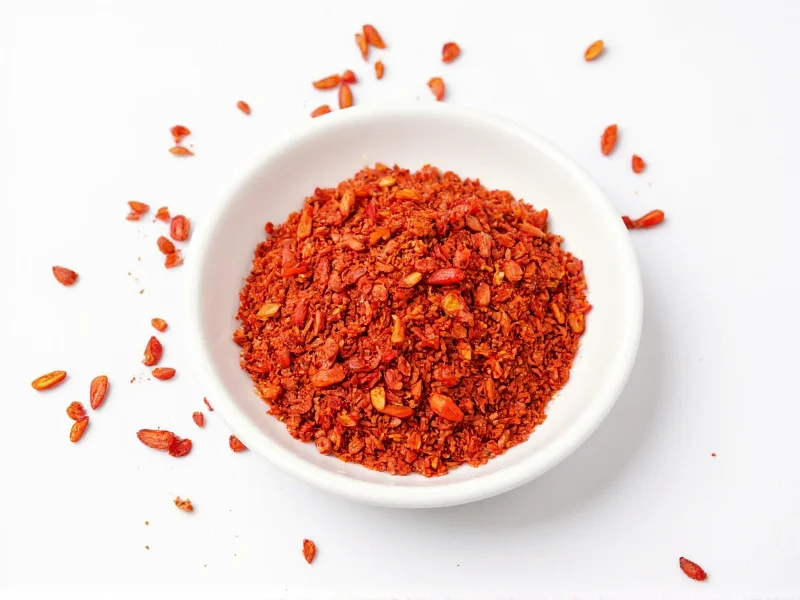Understanding where crushed red pepper falls on the heat scale helps home cooks and professional chefs alike control spice levels in recipes. Unlike single-variety peppers, crushed red pepper refers to a blend of dried, crushed chili peppers—most commonly cayenne, but often including red jalapeños, serranos, and other regional varieties. This mixture creates a complex flavor profile with moderate heat that enhances dishes without overwhelming them.
What Exactly Is Crushed Red Pepper?
Crushed red pepper consists of dried chili peppers that have been coarsely ground into flakes. Despite its name, it's not made from a single pepper variety. Commercial blends typically combine several types of red chili peppers, with cayenne being the dominant component in most U.S. products. The specific mix varies by brand and region, which explains the wide range in heat intensity.
Understanding the Scoville Scale
The Scoville scale measures chili pepper heat by determining capsaicin concentration—the compound responsible for spiciness. Developed by pharmacist Wilbur Scoville in 1912, the scale assigns values in Scoville Heat Units (SHU) based on how much sugar-water solution is needed to neutralize the heat.
Modern testing uses high-performance liquid chromatography for precise measurements, but the Scoville scale remains the standard reference for consumers. The scale ranges from zero (bell peppers) to over 2 million SHU (pure capsaicin).
Crushed Red Pepper Heat Range Explained
Crushed red pepper's heat level varies significantly based on the specific peppers used in the blend:
| Pepper Type | Scoville Heat Units | Compared to Crushed Red Pepper |
|---|---|---|
| Bell Pepper | 0 SHU | Not spicy |
| Paprika | 100–500 SHU | Much milder |
| Crushed Red Pepper (typical) | 500–22,000 SHU | Reference point |
| Cayenne Pepper | 30,000–50,000 SHU | Significantly hotter |
| Habanero Pepper | 100,000–350,000 SHU | Extremely hotter |
Most supermarket crushed red pepper falls in the 5,000–15,000 SHU range. This makes it noticeably spicier than paprika but substantially milder than pure cayenne powder. The variation occurs because:
- Pepper composition: Blends may contain different ratios of cayenne, jalapeño, and other varieties
- Regional differences: Italian-style crushed pepper often uses different varieties than American blends
- Processing methods: How peppers are dried and crushed affects heat retention
- Seed content: Higher seed content increases heat (seeds contain concentrated capsaicin)
Factors That Influence Crushed Red Pepper Heat
Several elements contribute to the final heat level of your crushed red pepper:
Pepper Variety Composition
While many assume crushed red pepper equals cayenne, most commercial blends combine multiple pepper types. A blend heavy on milder peppers like guajillo will sit at the lower end (500–5,000 SHU), while those emphasizing hotter varieties like bird's eye chilies will approach 22,000 SHU.
Geographical Origin
Italian crushed red pepper often uses Calabrian chilies (4,000–25,000 SHU), creating a fruitier, moderately spicy product. American-style blends typically feature more cayenne, resulting in sharper heat. Mexican versions might incorporate arbol peppers (15,000–30,000 SHU), pushing the blend toward the higher end of the scale.
Processing Techniques
Drying methods significantly impact heat retention. Sun-dried peppers often develop more complex flavors with slightly reduced heat compared to oven-dried varieties. The coarseness of the grind also matters—finer grinds expose more capsaicin-containing membranes, potentially increasing perceived heat.
Practical Culinary Applications
Understanding crushed red pepper's position on the heat scale helps you use it effectively in cooking. Its medium heat level makes it versatile for numerous applications:
- Pizza and pasta dishes: Sprinkle sparingly for subtle heat that complements tomato sauces
- Marinades and rubs: Combine with olive oil for balanced heat distribution
- Roasted vegetables: Toss with root vegetables before roasting for smoky warmth
- Breakfast dishes: Add to eggs or avocado toast for morning spice
When substituting crushed red pepper in recipes, consider these equivalents:
- 1/4 teaspoon crushed red pepper ≈ 1/8 teaspoon cayenne powder (use less cayenne)
- 1/2 teaspoon crushed red pepper ≈ 1 fresh jalapeño (seeded and minced)
- 1 teaspoon crushed red pepper ≈ 1 serrano pepper (seeded and minced)
Storage Tips for Maintaining Flavor and Heat
Proper storage preserves both the heat level and flavor complexity of crushed red pepper:
- Keep in an airtight container away from light and moisture
- Store in a cool, dark cupboard (not above the stove where heat fluctuates)
- Use within 6–12 months for optimal flavor (heat diminishes over time)
- Freeze for long-term storage (up to 2 years) in an airtight container
Over time, all dried peppers gradually lose potency. If your crushed red pepper no longer provides expected heat, it's likely past its prime rather than being an unusually mild blend.
Common Misconceptions About Crushed Red Pepper Heat
Several myths persist about crushed red pepper's heat level:
- Misconception: Crushed red pepper and red pepper flakes are different products
Reality: They're identical—just different naming conventions by region or brand - Misconception: All crushed red pepper has the same heat level
Reality: Heat varies significantly between brands and regions - Misconception: The red color indicates higher heat
Reality: Color relates to ripeness, not necessarily heat level











 浙公网安备
33010002000092号
浙公网安备
33010002000092号 浙B2-20120091-4
浙B2-20120091-4